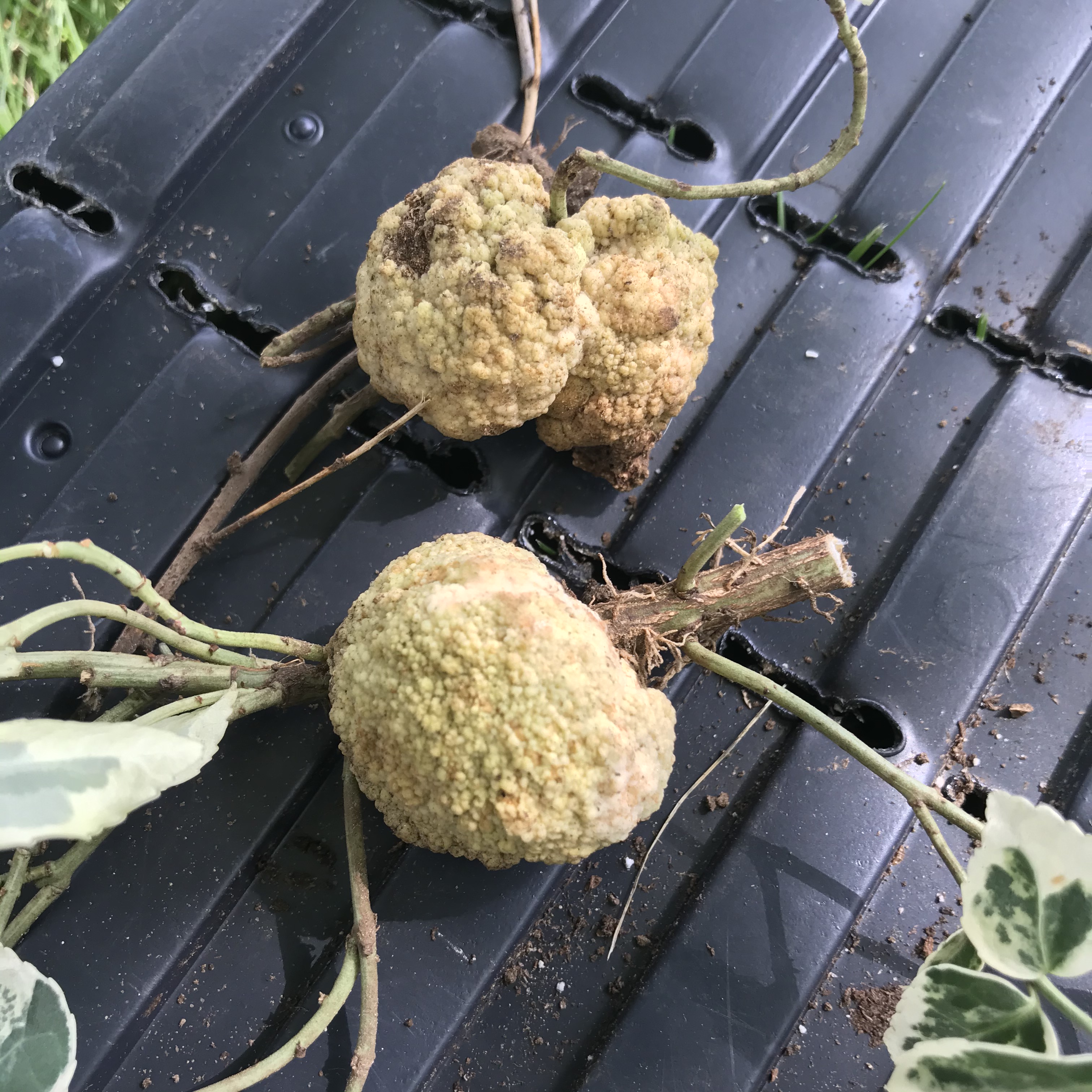Crown gall on a wintercreeper euonymus (Euonymus fortunei). Photo: Therese Houde
Question: I’m attaching a photo taken in my flower bed. What are the two white masses growing on the branch of my wintercreeper euonymus? They are as hard as rock with a rough exterior. This is the first time I’ve seen this kind of thing. I thought they were mushrooms at first, but they don’t have the right texture.
Therese Houde
Answer: They’re crown galls, aka crown gall tumors, a disease caused by the bacterium Agrobacterium tumefaciens. It usually forms on the crown of the plant, its roots or branches low to the ground, but sometimes higher on the main stem. It often enters plant cells through a small wound caused by hoeing, grafting, cold damage or root-eating insects. Once inside the plant, the bacteria stimulate the plant’s cells to proliferate, forming a gall that can develop over several years. The gall reduces sap flow and weakens the plant, but rarely kills it, at least, not until several years have passed.

The galls you’ve found are actually still quite young. Eventually they’ll turn brown and woody and indeed, it’s at that stage that they are particularly infectious.
Treatment
Ideally, affected shrubs should be destroyed by pulling them up and burning them or putting them out with the trash. Don’t put infected plant parts in the compost bin.
However, it’s sometimes possible to excise the gall when it appears on a secondary stem. If so, clean the pruning shears with isopropyl alcohol between each cut and before using it again. Afterward, paint the wound with pruning paint (one of the few true practical uses for this product!) If the gall does grow back, which it often does, it would be best to resign yourself to eliminating the plant.
Prevention
Avoid planting other plants sensitive to crown gall in that location before at least 2 years. There are over 140 species known to be susceptible to it, including other euonymus, forsythias, willows, grape vines and many plants in the rose family (apples, roses, peaches, etc.). You should also make sure you extract the whole plant and destroy any galls, because if you leave one in the soil, the bacteria can survive even longer: up to 5 years.
Preferably install plants resistant to crown gall in that spot. Most annuals and conifers are resistant as are the following woody plants:
- Barberry (Berberis spp.);
- Beech (Fagus spp.)
- Birch (Betula spp.)
- Black gum (Nyssa spp.)
- Boxwood (Buxus spp.)
- Catalpa (Catalpa spp.)
- Deutzia (Deutzia spp.)
- Ginkgo (Ginkgo biloba)
- Golden raintree (Koelreuteria spp.)
- Holly (Ilex spp.)
- Hornbeam (Carpinus spp.)
- Linden (Tilia spp.)
- Magnolia (Magnolia spp.)
- Mahonia (Mahonia spp.)
- Redbud (Cercis spp.)
- Serviceberry (Amelanchier spp.)
- Smoke tree (Cotinus spp.)
- Sweet gum (Liquidambar spp.)
- Tulip tree (Liriodendron spp.)
- Yellowwood (Cladastris kentuckea)
- Zelkova (Zelkova spp.)

? Helpful Hint: Use extra care when using a string trimmer, used for cutting back lawn grasses in places where the lawnmower can’t reach, near woody plants. It injures the bark of such plants and that allows the bacteria to penetrate. It would be wise to protect the base of any trees and shrubs growing in a lawn with a tree guard.
If ever you want to replant another euonymus in this location, dig up the original plant and remove all the soil in the area, then replace with soil harvested elsewhere before planting. And be careful not to injure the new euonymus as you plant. The success rate with this method is limited, however, because, despite these efforts, some bacteria may still linger in the surrounding soil and work their way back to the new euonymus.

Most likely your wintergreen euonymus (Euonymus fortunei) was already infected with a first gall at the time of purchase. Before purchasing another specimen, therefore, carefully inspect the plant to make sure there are no abnormal growths. Or have someone at the nursery inspect for you: young galls are quite subtle, but still visible if you know what to look for.

Yuck!
Wow! So interesting! I remember removing a growth, something like this, earlier in the summer. But I cannot remember what I removed it from, only that I was surprised to find it. It may have been a carpet rose. I will be on the lookout! Thanks for the great article.
It could be a carpet rose: it would look just like the photo.